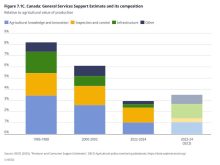Canadian farmers will need to grow a lot more canola to meet global demand, with emission reduction goals both a key driver and central concern, said agriculture leaders during the Canola Council of Canada’s (CCC) “Canola Week” conference on November 30.
“The long-term demand signal for canola is strong,” said CCC president Jim Everson.
Why it matters: Canola could win and lose in the climate battle.
Everson told the online audience that while buffeted by challenges like drought, the ongoing pandemic, supply chain issues, and continued disruption of trade to China, Canada’s canola outlook is bright.
He cited “the world’s growing middle class,” which is seeking out healthier foods “like canola oil and canola protein,” and falling demand for palm oil due to sustainability concerns.
Green fuel demand

Most significantly, said Everson, countries like Canada and the U.S. are introducing sustainable fuel mandates.
“This is a huge opportunity for our industry, because canola oil is one of the best feedstocks available for renewable fuels,” Everson said.
Demand for biofuels, along with demand for canola meal and oil, is driving investment into canola processing in Canada, said Chris Vervaet, executive director of the Canadian Oilseed Processors Association (COPA).
Canada’s crush capacity is projected to reach just under 17 million metric tons by 2025, up from 11 MMT in 2020, Vervaet said.
Demand for renewable diesel in Canada may reach between one billion and 1.2 billion litres by 2025, up from 740 million litres in 2020, and between 1.9 billion and just under three billion litres by 2030.
Read Also

Still hard to predict precise fertilizer payback
Despite decades of advances, international research finds no clear answer for where and when adding nutrient will fail to boost growth.
Overall, there’s a possibility of a 50 per cent increase in biofuel demand in the U.S. and Canada by 2030, Vervaet said.
“There’s a lot of optimism,” he said.
CCC is calling on the federal government to include canola-based fuels in its clean fuel standard, which is under development, Everson said.
This will require four times more canola, said Vervaet.
“Simply growing more canola to keep up with demand” in a sustainable and profitable way will be a challenge, said Everson.
The canola sector has set a target to increase productivity to an average of 52 bushels per acre, up from about 40 bu./ac. Everson called this “job No. 1.”
This will require continued advancement in agronomic practices, smart fertilizers, higher-yielding cultivars and a wide range of resistance to disease, weather and other threats, said Everson.
“Investments in research and innovation will again be the answer,” he said.
Everson called on governments to cough up more cash.
“It would be a mistake to reduce funding to market access and promotion, to technology adaptation and to grower agronomic research by shifting existing resources to other challenges,” he said. “To meet the challenge of climate change, governments will need to increase funding.”
Nitrogen emissions
Speakers also expressed concerns about the federal government’s call to reduce emissions from fertilizer use, which it announced in December 2020.
Everson said achieving this by reducing fertilizer use could hinder farmers’ competitiveness.
“Nitrogen fertilizer is a critical tool for farmers,” he said. “Reducing emissions from fertilizer cannot be simply regulating reductions in fertilizer use.”
Instead, the objective needs to be reducing emissions through innovation, said Everson.
The government’s target is reduced emissions, not reduced use, said Cassandra Cotton, director of sustainability with Fertilizer Canada. However, she said the government has signalled it will pursue an absolute reduction in emissions, not a target based on intensity.
Absolute reduction means a reduction in total greenhouse gases emitted, while a reduction intensity means a reduction in greenhouse gases emitted per economic unit.
“By very definition, from that, it would require a reduction in use to meet those targets,” she said.
Cotton said the government set this target with no consultation or collaboration with the agriculture industry at large, and did not base it on science or economic modelling.
Earlier this year, Fertilizer Canada and Meyers Norris Penny released a study that showed economic effects of reducing fertilizer use by 20 per cent between 2023 and 2030, which was based on the European Union’s model for emission reduction — Canada has not released its plan. It said this could cost farmers almost $48 billion.
Critics called the findings accurate but misleading, since it assumed farmers wouldn’t change practices to keep yields from falling, and they accused the industry of trying to protect its own economic interests.
Cotton said the study was meant to set a baseline understanding of what fertilizer reduction might mean, and to look at other jurisdictions.
She reiterated Fertilizer Canada’s call for the federal government to officially recognize 4R Nutrient Stewardship (right place, right time, right rate and right source) and implement the 4R Climate-Smart Protocol, also known as the Nitrous Oxide Emission Reduction Protocol (NERP) to reach its emission targets.
A 2018 report by David Burton suggested NERP, which implements 4R practices, could reduce on-farm greenhouse gas emissions by up to 35 per cent.
















